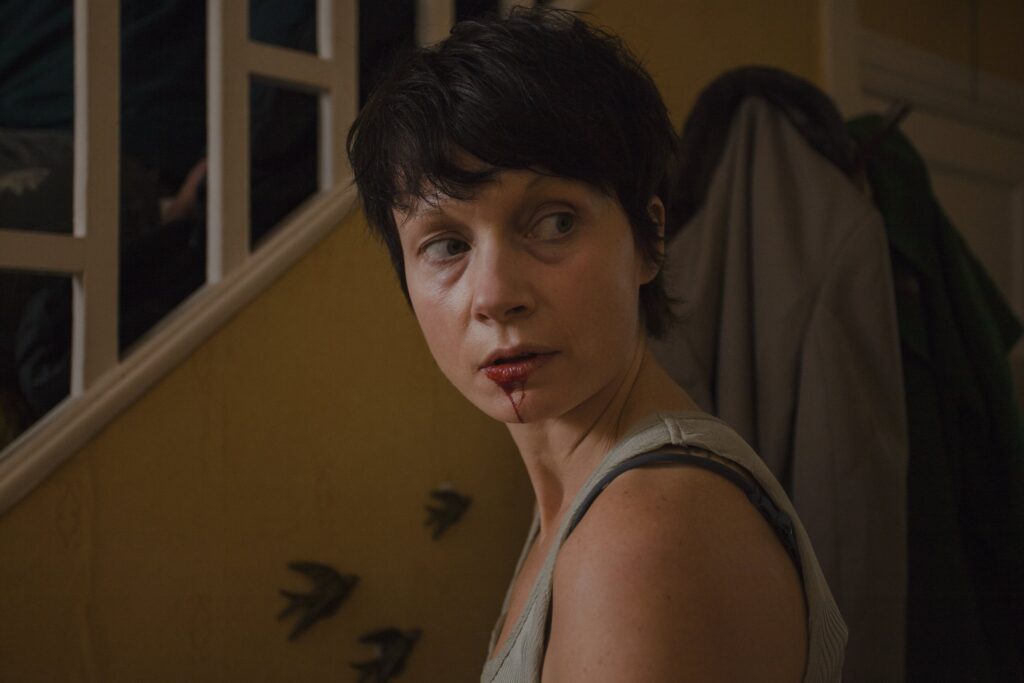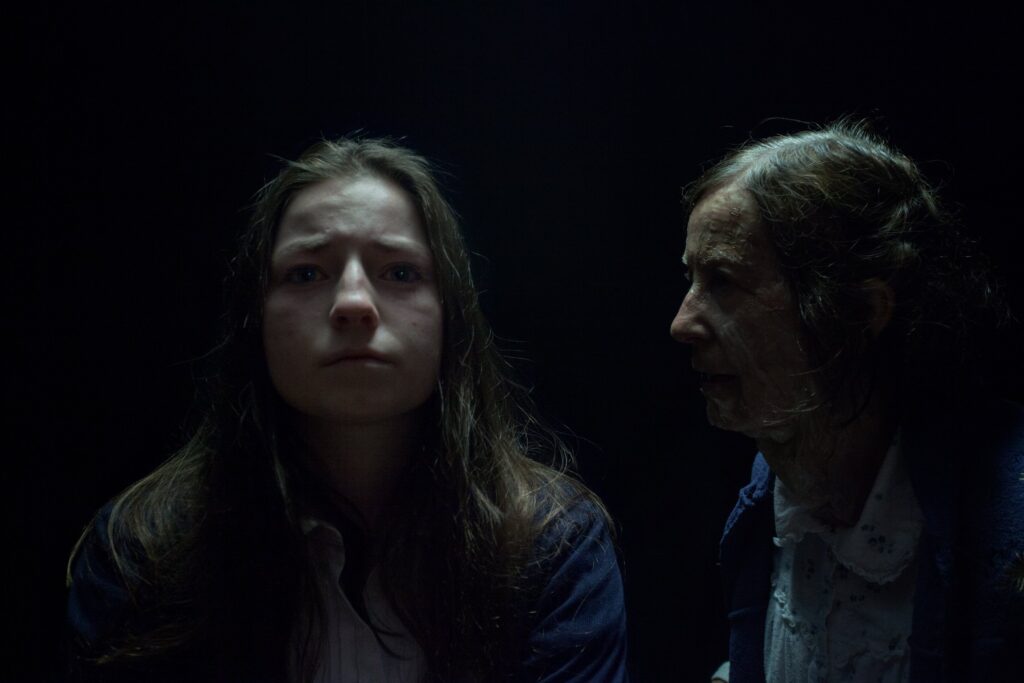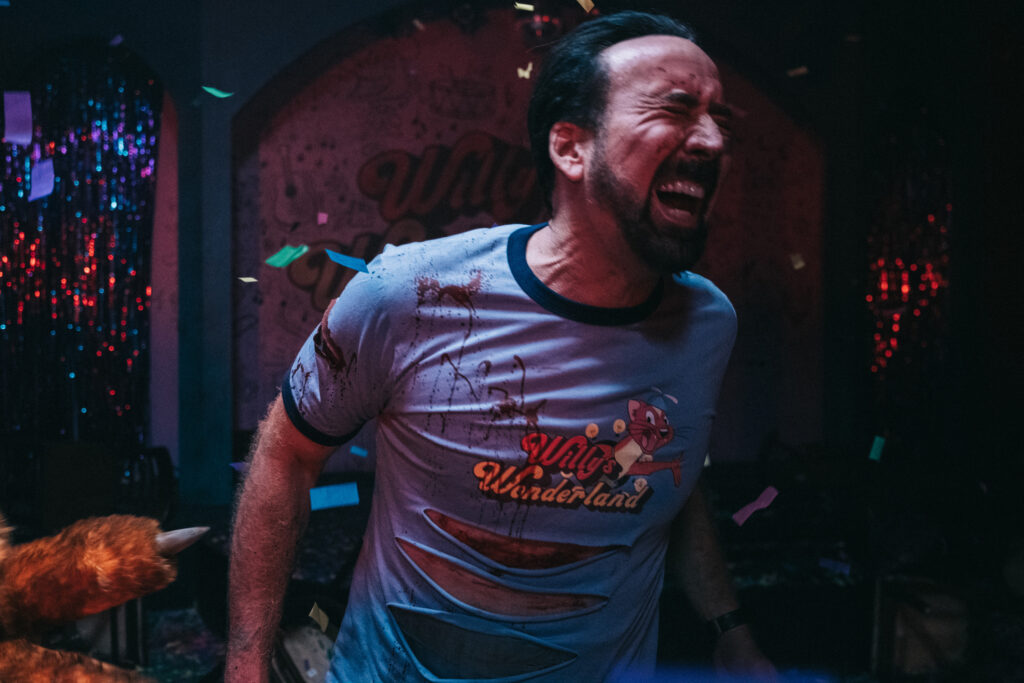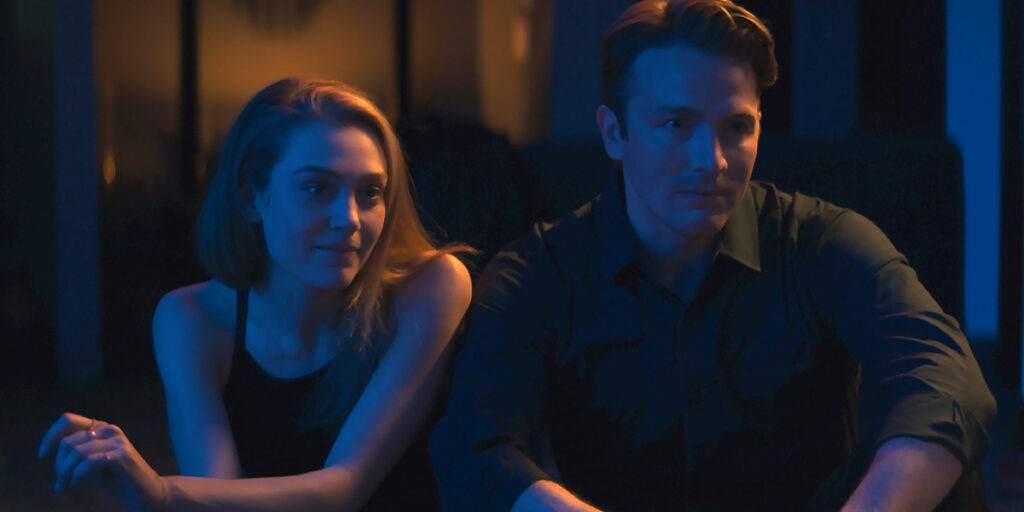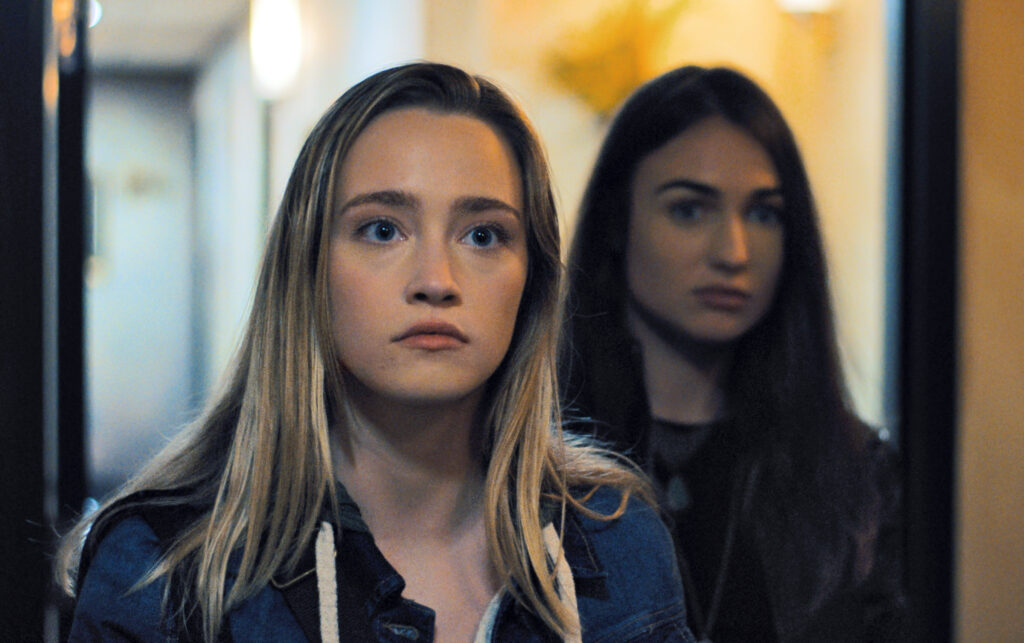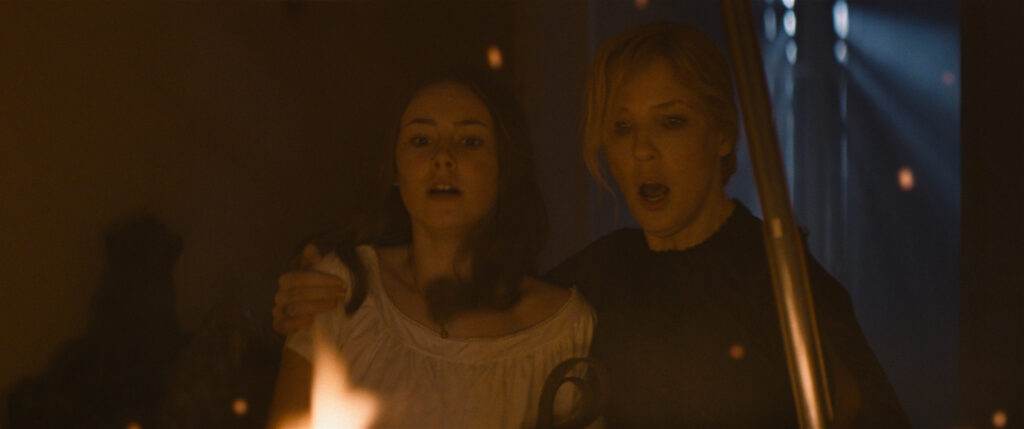April 27, 2022
by Carla Hay
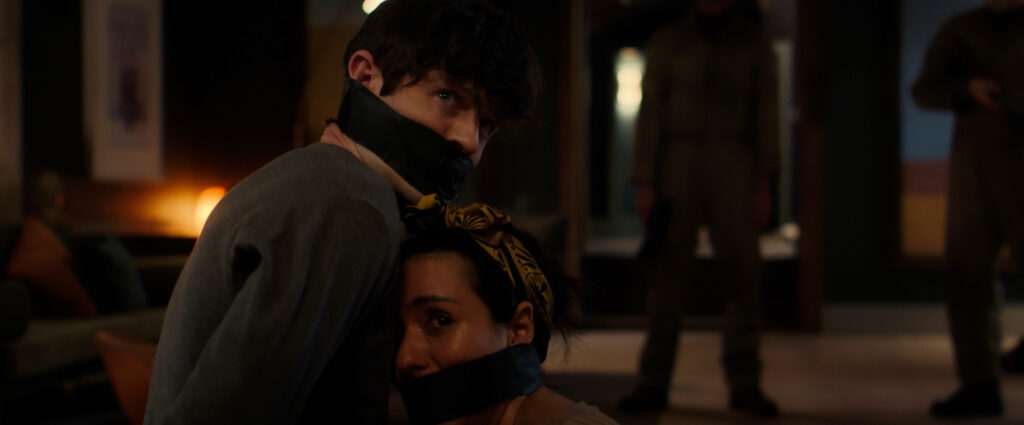
Directed by Charles Dorfman
Culture Representation: Taking place in Surrey, England, the horror film “Barbarians” features a cast of nearly all-white characters (with one Latina) representing the middle-class.
Culture Clash: Four people who are gathered for a dinner party have their party interrupted by home invaders.
Culture Audience: “Barbarians” will appeal primarily to people who don’t mind watching an unimaginative and dull horror movie that has too many boring conversations and not enough scares.
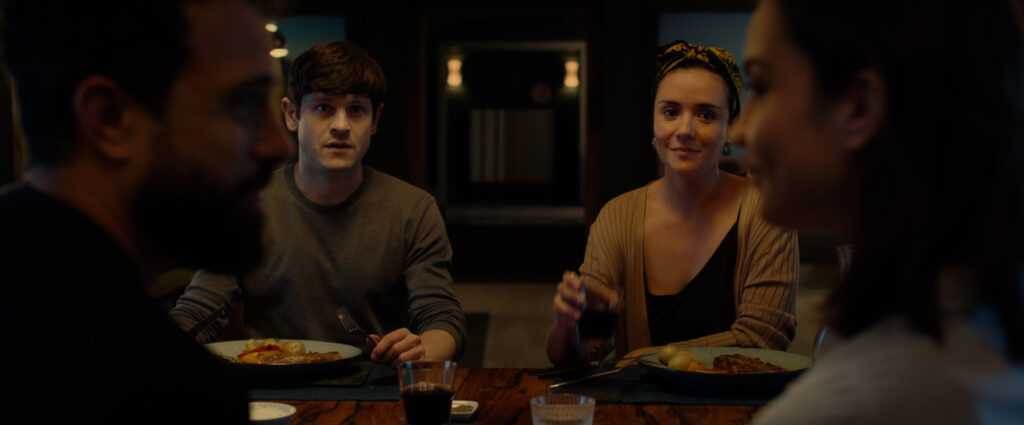
“Barbarians” is being marketed as a horror movie about a home invasion. It’s actually a tedious 90-minute movie about an annoying dinner party, with the formulaic home invasion happening only in the last 30 minutes. There’s no good excuse for why the movie drags on and on in showing nothing but the dinner party hosts and their relationship issues before and during this dreadfully boring dinner party. It all just comes down to a horror movie being lazy and unimaginative.
Written and directed by Charles Dorfman, “Barbarians” (which takes place during a 24-hour period in Surrey, England) wastes a lot of time showing the movie’s central couple’s relationship conflicts and some background about the home that they have recently purchased. Adam Davies (played by Iwan Rheon) is a movie director who’s frustrated because his career has stalled. His partner Eva Velasquez (played by Catalina Sandino Moreno) is a world-renowned artist whose specialty is making large sculptures. Adam and Eva, who are both in their late 30s to early 40s, are not married and have been together for an untold number of years.
Adam and Eva have recently moved into a housing property development called The Gateway, which has been designed to be a progressive community of homes for like-minded creative people and other “hipsters.” A massive stone sculpture made by Eva is at the center of the property. It’s an avant-garde eyesore that’s being touted as “bespoke sculpture.”
Real-estate developer Lucas Hunt (played by Tom Cullen) has sold Adam and Eva a house in The Gateway. Lucas hopes to sell more housing units, so he has made a promotional video that he has posted on the Internet. The opening scene of “Barbarians” is a clip from this slick promotional video, where Lucas has the tone of an infomercial hack.
In this video, Lucas talks about how The Gateway got its name from a famous stone on the land called Gaeta (which is Gaelic for “gateway”), which has “attracted people far and wide with its mystery, its magic, its power. They come to celebrate the solstice as a way of marking the transition from one season to another.” Eva’s sculpture adorning the property is meant to resemble the Gaeta stone. Lucas mentions that the land where The Gateway is located had been owned for generations by a family with the last name Wickes.
Lucas says in the video that he worked out a deal with the Wickes family to sell the property to him, by assuring the family that for this land “steeped in history,” he would be “respecting its past to create something truly special.” As if to prove that he had the Wickes family’s blessing, the video includes Lucas posing for a photo with family patriarch Alan Wickes (played by Kevin Ryan) and Alan’s three sons: John (played by Will Kemp), Dan (played by Connor Swindells) and Neil (played by Tommy McDonnell). Everyone is smiling and seeming to be on good terms with other.
There’s a pointless part of the movie about a wounded fox that Adam finds outside on the property, because the fox got caught in some fence wire. When Adam approaches the fox to try to help it, the fox snarls and snaps at him, so Adam backs off. Later, the fox mysteriously shows up on the kitchen floor in Adam and Eva’s house.
Dan Wickes just happens to be there, and he covers the wounded fox with a jacket and kills it with no hesitation. The killing of this fox really has no bearing on the story, except to show that Dan can get violent (even in a “mercy killing” of an animal), and Adam feels emasculated in his own home because Dan acted in a “macho” way to kill the fox. Adam also thinks that Dan flirts inappropriately with Eva, but she denies it.
Adam’s birthday happens around the same time that he and Eva have moved into their new home, so Adam and Eva are throwing a small dinner party to celebrate. Their only guests at this party are Lucas and his actress girlfriend Chloe (played by Inès Spiridonov), who has been in a relationship with Lucas for an unnamed period of time. “Barbarians” (which is writer/director Dorfman’s feature-film directorial debut) is a poorly made movie that skips over a lot of character development. All four of these characters come across as very shallow and often self-absorbed, with unremarkable acting from all of the movie’s cast members.
The main thing that viewers will learn about Adam and Eva before this dinner party happens is that Eva wants to start a family with Adam, who is more reluctant about the idea of being a parent at this point in his life. Adam seems to want to wait until he has a more stable income. Eva is frustrated by his hesitation, so she tells Adam that if he’s not ready to have a family with her, he needs to be up front and tell her. Adam says he’s sorry and tells Eva that he’s committed to her and will go with what she wants.
The dinner party is just more irksome relationship drama, with Adam and Lucas acting like immature rivals. Adam feels like an insecure “beta male” because he thinks “alpha male” Lucas is trying to make flirtatious moves on Eva. That seems to be a pattern of jealousy that Adam has when another man is interacting with Eva. Lucas thinks Adam is kind of a wimp. Lucas tells Adam to hit Lucas. Adam doesn’t punch Lucas but slaps him instead, so Lucas calls Adam a “pussy.”
And it should come as no surprise that some secrets, lies and betrayals are revealed during this dinner party. The identities of the home invaders (who wear animal skull masks) and the reason for the home invasion are so obvious, this movie has no real suspense or mystery. By the time the horribly staged home invasion happens during the dinner party, viewers will feel like “Barbarians” invited people to a horror movie, but instead offered a time-wasting void of monotonous and forgettable drivel.
IFC Films/IFC Midnight released “Barbarians” in select U.S. cinemas, on digital and VOD on April 1, 2022.

